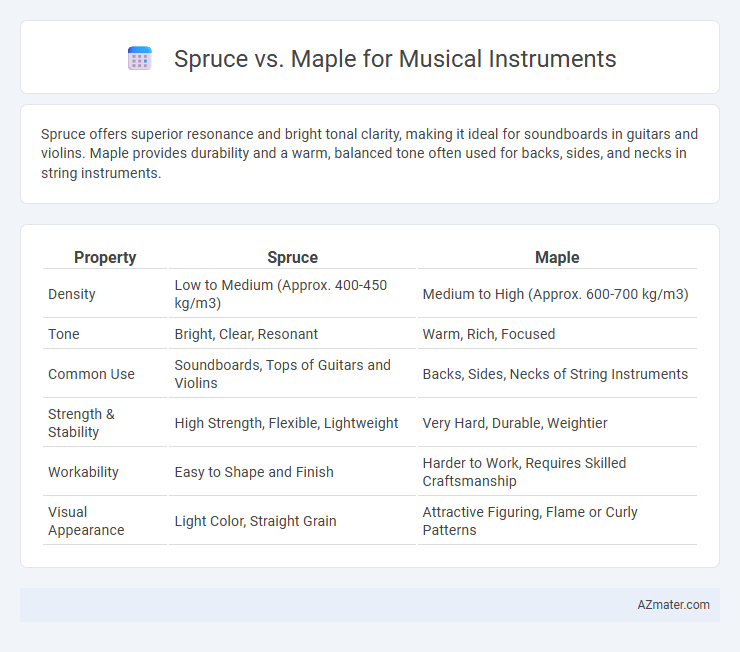Spruce offers superior resonance and bright tonal clarity, making it ideal for soundboards in guitars and violins. Maple provides durability and a warm, balanced tone often used for backs, sides, and necks in string instruments.
Table of Comparison
| Property | Spruce | Maple |
|---|---|---|
| Density | Low to Medium (Approx. 400-450 kg/m3) | Medium to High (Approx. 600-700 kg/m3) |
| Tone | Bright, Clear, Resonant | Warm, Rich, Focused |
| Common Use | Soundboards, Tops of Guitars and Violins | Backs, Sides, Necks of String Instruments |
| Strength & Stability | High Strength, Flexible, Lightweight | Very Hard, Durable, Weightier |
| Workability | Easy to Shape and Finish | Harder to Work, Requires Skilled Craftsmanship |
| Visual Appearance | Light Color, Straight Grain | Attractive Figuring, Flame or Curly Patterns |
Introduction to Spruce and Maple in Luthiery
Spruce and maple are foundational tonewoods in luthiery, each offering distinct acoustic properties crucial for musical instruments. Spruce, known for its exceptional strength-to-weight ratio and stiffness, delivers bright, clear, and responsive sound, making it ideal for soundboards in guitars, violins, and other string instruments. Maple, characterized by its dense grain and durability, provides a warm, focused tone and is commonly used for backs, sides, and necks, contributing to structural integrity and aesthetic appeal.
Botanical and Physical Characteristics
Spruce, primarily from the genus Picea, features a lightweight, straight-grained wood with excellent stiffness-to-weight ratio, making it ideal for soundboards in musical instruments due to its superior resonance and dynamic range. Maple, belonging to the Acer genus, is denser and harder, providing durability and bright tonal clarity often used for backs, sides, and necks of string instruments. The contrast in cellular structure between the softwood spruce and hardwood maple influences their acoustic properties, with spruce offering enhanced vibration transmission and maple contributing to sustain and projection.
Acoustic Properties: Tone and Resonance
Spruce is highly valued for its bright, clear tone and strong resonance, making it a preferred choice for soundboards in acoustic guitars and violins. Maple, while offering a warmer and more focused sound with pronounced midrange frequencies, excels in providing sustain and clarity, especially in backs and sides of instruments. The choice between spruce and maple significantly affects the instrument's tonal balance, with spruce enhancing projection and maple contributing to a rich, complex harmonic content.
Spruce: Common Uses in Instrument Making
Spruce is the preferred wood for soundboards in guitars, violins, and pianos due to its exceptional strength-to-weight ratio and resonance, which enhances tonal clarity and projection. Its fine, straight grain allows for precise vibration transfer, resulting in a bright, responsive sound favored by luthiers for crafting acoustic instruments. Compared to maple, which is commonly used for backs and sides for its hardness and aesthetic appeal, spruce excels in producing the primary soundboard vibrations critical to instrument acoustics.
Maple: Common Uses in Instrument Making
Maple is widely favored in musical instrument making for its dense grain and bright tonal qualities, often used in the construction of guitar backs, sides, and necks, as well as violin and cello backs. Its durability and attractive figuring, such as flame or quilt patterns, make it a popular choice for both acoustic and electric stringed instruments. The hardness of maple contributes to a strong sustain and clear sound projection, enhancing the overall performance of the instrument.
Comparative Durability and Workability
Spruce offers superior durability with its high strength-to-weight ratio, making it a preferred choice for soundboards in musical instruments due to its resilience and resistance to cracking under tension. Maple, while slightly less durable, excels in workability, allowing for intricate carving and shaping, which is ideal for instrument backs, necks, and sides that require precise craftsmanship. Both woods balance strength and flexibility, but spruce's lighter density enhances tonal projection, whereas maple's hardness ensures long-term structural integrity.
Influence on Sound Quality and Projection
Spruce is widely favored for musical instrument soundboards due to its excellent strength-to-weight ratio, which enhances sound quality with bright, clear tones and strong projection. Maple, often used for backs and sides, contributes to a warmer, more focused sound and adds resonance and sustain without overpowering volume. The combination of spruce tops and maple bodies is popular for achieving a balanced sound with both clarity and rich tonal depth.
Visual Appeal and Aesthetic Differences
Spruce offers a pale, creamy color with a fine, straight grain that creates a smooth, classic look favored for its subtle elegance in musical instruments. Maple exhibits a warmer hue with a natural shimmer and distinctive flame or quilt patterns, providing a visually striking and dynamic appearance. The choice between spruce and maple impacts not only sound but also the instrument's aesthetic, with spruce delivering understated sophistication and maple offering bold, eye-catching beauty.
Cost and Availability Worldwide
Spruce is widely preferred for musical instruments due to its excellent resonance and relatively lower cost, making it more accessible worldwide compared to maple. Maple, prized for its durability and bright tonal qualities, tends to be more expensive and less readily available globally, especially high-grade varieties needed for premium instruments. The cost disparity and supply limitations make spruce the more practical choice for both manufacturers and musicians across diverse markets.
Spruce vs Maple: Choosing the Right Wood for Your Instrument
Spruce offers exceptional resonance and clarity, making it the preferred choice for soundboards in guitars and violins due to its lightweight and flexible grain. Maple, known for its density and durability, provides a bright, sustained tone and is commonly used for backs, sides, and necks in string instruments. Selecting spruce or maple depends on the desired tonal quality and structural function, with spruce enhancing projection and maple adding strength and brightness.

Infographic: Spruce vs Maple for Musical Instrument
 azmater.com
azmater.com